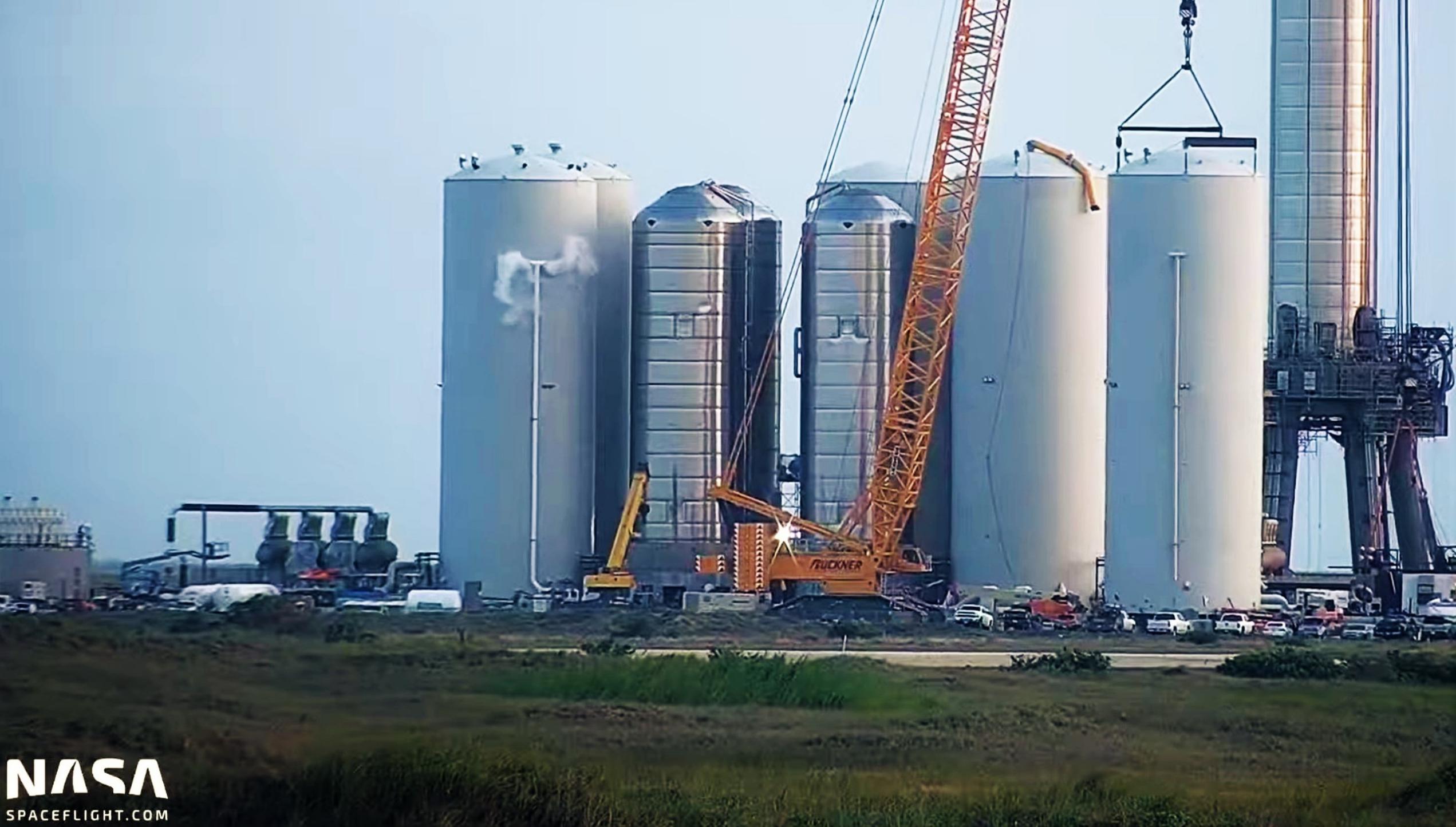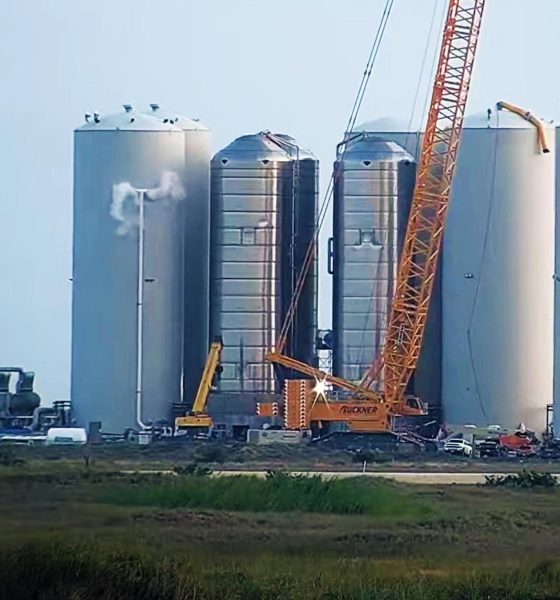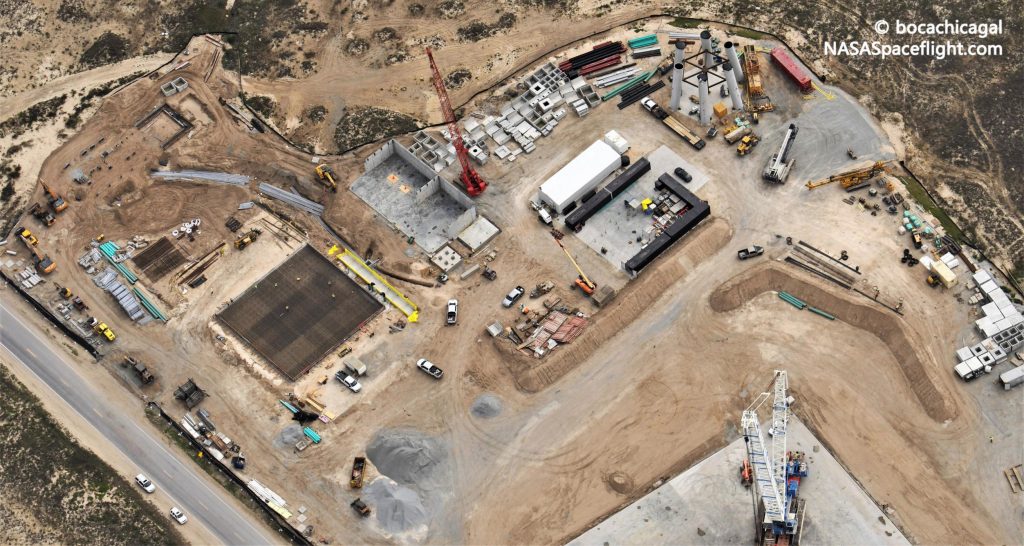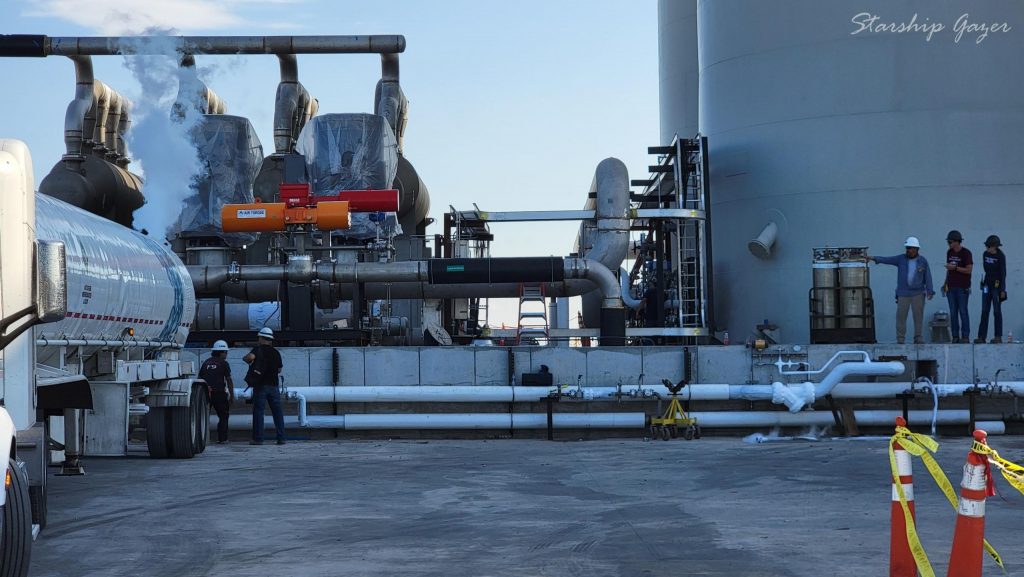

News
SpaceX’s orbital Starship launch pad tank farm comes to life for the first time
Update: Two days after a bevy of tanker trucks began to arrive at SpaceX’s orbital Starship launch site with load upon load of cryogenic liquid nitrogen, the company’s custom-built tank farm appears to have taken its very first ‘breaths.’
In other words, at least one of seven massive propellant storage tanks – two of which appear to have been fully completed and insulated – began venting. For a tank like SpaceX’s ground support equipment (GSE) tanks, the level of venting observed can only mean one thing: pressure maintenance during operations with cryogenic fluids. As cryofluids are loaded into empty tanks, they inevitably come into contact with warm pipes and tank walls, rapidly warming a portion of the liquid that then boils into gas. Tanks then need to vent that excess gas to avoid bursting.
In the case of SpaceX’s two completed liquid oxygen GSE tanks and a spate of liquid nitrogen (LN2) deliveries this week, it’s clear that the company has begun the process of testing and activating part of its brand new orbital-class Starship tank farm – beginning with much less risky LN2 proof testing. Filling the two finished LOx tanks with LN2 should also serve the dual purpose of flushing and cleaning them of any debris or contaminants, ensuring that it’s safe to fill them with LOx when the time comes.
For the first time, SpaceX appears to have begun delivering large quantities of cryogenic fluids to Starship’s orbital launch pad – still under construction but fast approaching some level of initial operational capability.
Sometime in the morning on September 19th, a semi-truck carrying a cryogenic liquid nitrogen (LN2) transport trailer arrived at SpaceX’s Starbase launch facilities. Normally, that would be a completely mundane, uninteresting event: SpaceX has used and will continue to use liquid nitrogen to safely proof test Starship prototypes and supercool their liquid methane (LCH4) and oxygen (LOx) propellant for the indefinite future. However, up to now, 100% of all Starbase cryogen deliveries have gone to the suborbital launch site, where two “mounts” and a few concrete aprons have supported all Starship and Super Heavy tests and launches to date.
Instead, this particular LN2 tanker headed for Starbase’s first orbital tank farm and began to offload its cryogenic liquid cargo at a number of brand new fill stations specifically designed for the task.
Still well under construction and at least a few weeks or months from total complete, Starship’s orbital launch site tank farm will ultimately be a group of eight massive storage tanks surrounded by thousands of feet of insulated plumbing, industrial pumps, a small army of “cryocoolers,” a blockhouse filled with human-sized valves, and much more. Said tank farm has been under construction for the better part of 2021, beginning with work on its concrete foundation this January.
Nine months later, the orbital tank farm is nearly complete. A power distribution and communications blockhouse has been complete for weeks with virtually all the wiring and cabling needed for the orbital launch mount and tower already in place. Several hundred feet of concrete cable and plumbing conduit have been filled with thousands of feet of wires, cables, and pipes and been sealed and buried. The tank farm blockhouse – where a dozen or so massive valves control the flow of propellant to and from the orbital launch mount and tower – is complete save for some final plumbing.

Finally, seven of eight GSE (ground support equipment) tanks have been installed and partially plumbed. Built in the same factory, six are virtually identical to Starship and Super Heavy tanks and will store LOx (3x), LN2 (2x), LCH4 (2x), and around a million gallons of water. Save for one LCH4 tank, all have been installed at the farm and that last tank (known as GSE8) is nearly complete back at the build site. Additionally, to insulate those seven thin, steel storage tanks, SpaceX has contracted with a water/storage tank company to build seven “cryoshells” and said million-gallon water tank.
The water tank was installed months ago and all seven shells are completed and ready to go as of last month. Only two of those seven cryoshells have been installed – and, rather asymmetrically, both on LOx tanks. SpaceX recently rolled the first LN2 tank cryoshell to the farm and could install it soon but as of now, it will likely be weeks before the orbital tank farm will have sleeved, insulated LOx, LN2, and LCH4 tanks ready for testing.

At the moment, that’s one of the biggest points of uncertainty standing between SpaceX and the ability to test Super Heavy or Starship at the orbital launch site. It’s entirely unclear if uninsulated GSE tanks can support any kind of substantial testing – like, say, the first full Super Heavy static fire test campaign – before their contents effectively boil off. As such, it’s a bit of mystery why SpaceX then had at least three tanker loads of liquid nitrogen – likely more than 70 tons (~150,000 lb) total – delivered to the orbital tank farm on September 19th.
By all appearances the first time that the farm’s actual main tanks have been filled with anything, that liquid nitrogen seems to have been loaded into one or both of the two insulated LOx tanks. There are two or three main explanations. First, SpaceX could simply be testing those more or less completed tanks with their first cryogenic fluids. Those partial ‘cryo proof’ tests would also help clean and flush out the interior of the LOx tanks, removing mundane debris or contamination that could become a major hazard when submerged in a high-density oxidizer. Given that both tanks can easily hold ~1300 tons (~2.9M lb) of liquid nitrogen, 70 tons is more of a tickle than a test, though, so a magnitude more would need to be delivered to perform even a half-decent bare-minimum cryoproof.
The other distinct possibility is that SpaceX plans to temporarily use one or both of the only two finished orbital pad tanks to store liquid nitrogen for Super Heavy Booster 4’s first cryogenic proof test. Either way, SpaceX has test windows scheduled every day this week, beginning with a six-hour window that opens at 5pm CDT today (Sept 20). Stay tuned to find out what exactly SpaceX plans to test and if the orbital tank farm and its first taste of liquid nitrogen are involved!

Elon Musk
Elon Musk’s X will start using a Tesla-like software update strategy
The initiative seems designed to accelerate updates to the social media platform, while maintaining maximum transparency.

Elon Musk’s social media platform X will adopt a Tesla-esque approach to software updates for its algorithm.
The initiative seems designed to accelerate updates to the social media platform, while maintaining maximum transparency.
X’s updates to its updates
As per Musk in a post on X, the social media company will be making a new algorithm to determine what organic and advertising posts are recommended to users. These updates would then be repeated every four weeks.
“We will make the new 𝕏 algorithm, including all code used to determine what organic and advertising posts are recommended to users, open source in 7 days. This will be repeated every 4 weeks, with comprehensive developer notes, to help you understand what changed,” Musk wrote in his post.
The initiative somewhat mirrors Tesla’s over-the-air update model, where vehicle software is regularly refined and pushed to users with detailed release notes. This should allow users to better understand the details of X’s every update and foster a healthy feedback loop for the social media platform.
xAI and X
X, formerly Twitter, has been acquired by Elon Musk’s artificial intelligence startup, xAI last year. Since then, xAI has seen a rapid rise in valuation. Following the company’s the company’s upsized $20 billion Series E funding round, estimates now suggest that xAI is worth tens about $230 to $235 billion. That’s several times larger than Tesla when Elon Musk received his controversial 2018 CEO Performance Award.
As per xAI, the Series E funding round attracted a diverse group of investors, including Valor Equity Partners, Stepstone Group, Fidelity Management & Research Company, Qatar Investment Authority, MGX, and Baron Capital Group, among others. Strategic partners NVIDIA and Cisco Investments also continued support for building the world’s largest GPU clusters.
News
Tesla FSD Supervised wins MotorTrend’s Best Driver Assistance Award
The decision marks a notable reversal for the publication from prior years, with judges citing major real-world improvements that pushed Tesla’s latest FSD software ahead of every competing ADAS system.

Tesla’s Full Self-Driving (Supervised) system has been named the best driver-assistance technology on the market, earning top honors at the 2026 MotorTrend Best Tech Awards.
The decision marks a notable reversal for the publication from prior years, with judges citing major real-world improvements that pushed Tesla’s latest FSD software ahead of every competing ADAS system. And it wasn’t even close.
MotorTrend reverses course
MotorTrend awarded Tesla FSD (Supervised) its 2026 Best Tech Driver Assistance title after extensive testing of the latest v14 software. The publication acknowledged that it had previously criticized earlier versions of FSD for erratic behavior and near-miss incidents, ultimately favoring rivals such as GM’s Super Cruise in earlier evaluations.
According to MotorTrend, the newest iteration of FSD resolved many of those shortcomings. Testers said v14 showed far smoother behavior in complex urban scenarios, including unprotected left turns, traffic circles, emergency vehicles, and dense city streets. While the system still requires constant driver supervision, judges concluded that no other advanced driver-assistance system currently matches its breadth of capability.
Unlike rival systems that rely on combinations of cameras, radar, lidar, and mapped highways, Tesla’s FSD operates using a camera-only approach and is capable of driving on city streets, rural roads, and freeways. MotorTrend stated that pure utility, the ability to handle nearly all road types, ultimately separated FSD from competitors like Ford BlueCruise, GM Super Cruise, and BMW’s Highway Assistant.
High cost and high capability
MotorTrend also addressed FSD’s pricing, which remains significantly higher than rival systems. Tesla currently charges $8,000 for a one-time purchase or $99 per month for a subscription, compared with far lower upfront and subscription costs from other automakers. The publication noted that the premium is justified given FSD’s unmatched scope and continuous software evolution.
Safety remained a central focus of the evaluation. While testers reported collision-free operation over thousands of miles, they noted ongoing concerns around FSD’s configurable driving modes, including options that allow aggressive driving and speeds beyond posted limits. MotorTrend emphasized that, like all Level 2 systems, FSD still depends on a fully attentive human driver at all times.
Despite those caveats, the publication concluded that Tesla’s rapid software progress fundamentally reshaped the competitive landscape. For drivers seeking the most capable hands-on driver-assistance system available today, MotorTrend concluded Tesla FSD (Supervised) now stands alone at the top.
News
Elon Musk’s Grokipedia surges to 5.6M articles, almost 79% of English Wikipedia
The explosive growth marks a major milestone for the AI-powered online encyclopedia, which was launched by Elon Musk’s xAI just months ago.

Elon Musk’s Grokipedia has grown to an impressive 5,615,201 articles as of today, closing in on 79% of the English Wikipedia’s current total of 7,119,376 articles.
The explosive growth marks a major milestone for the AI-powered online encyclopedia, which was launched by Elon Musk’s xAI just months ago. Needless to say, it would only be a matter of time before Grokipedia exceeds English Wikipedia in sheer volume.
Grokipedia’s rapid growth
xAI’s vision for Grokipedia emphasizes neutrality, while Grok’s reasoning capabilities allow for fast drafting and fact-checking. When Elon Musk announced the initiative in late September 2025, he noted that Grokipedia would be an improvement to Wikipedia because it would be designed to avoid bias.
At the time, Musk noted that Grokipedia “is a necessary step towards the xAI goal of understanding the Universe.”
Grokipedia was launched in late October, and while xAI was careful to list it only as Version 0.1 at the time, the online encyclopedia immediately earned praise. Wikipedia co-founder Larry Sanger highlighted the project’s innovative approach, noting how it leverages AI to fill knowledge gaps and enable rapid updates. Netizens also observed how Grokipedia tends to present articles in a more objective manner compared to Wikipedia, which is edited by humans.
Elon Musk’s ambitious plans
With 5,615,201 total articles, Grokipedia has now grown to almost 79% of English Wikipedia’s article base. This is incredibly quick, though Grokipedia remains text-only for now. xAI, for its part, has now updated the online encyclopedia’s iteration to v0.2.
Elon Musk has shared bold ideas for Grokipedia, including sending a record of the entire knowledge base to space as part of xAI’s mission to preserve and expand human understanding. At some point, Musk stated that Grokipedia will be renamed to Encyclopedia Galactica, and it will be sent to the cosmos.
“When Grokipedia is good enough (long way to go), we will change the name to Encyclopedia Galactica. It will be an open source distillation of all knowledge, including audio, images and video. Join xAI to help build the sci-fi version of the Library of Alexandria!” Musk wrote, adding in a later post that “Copies will be etched in stone and sent to the Moon, Mars and beyond. This time, it will not be lost.”








